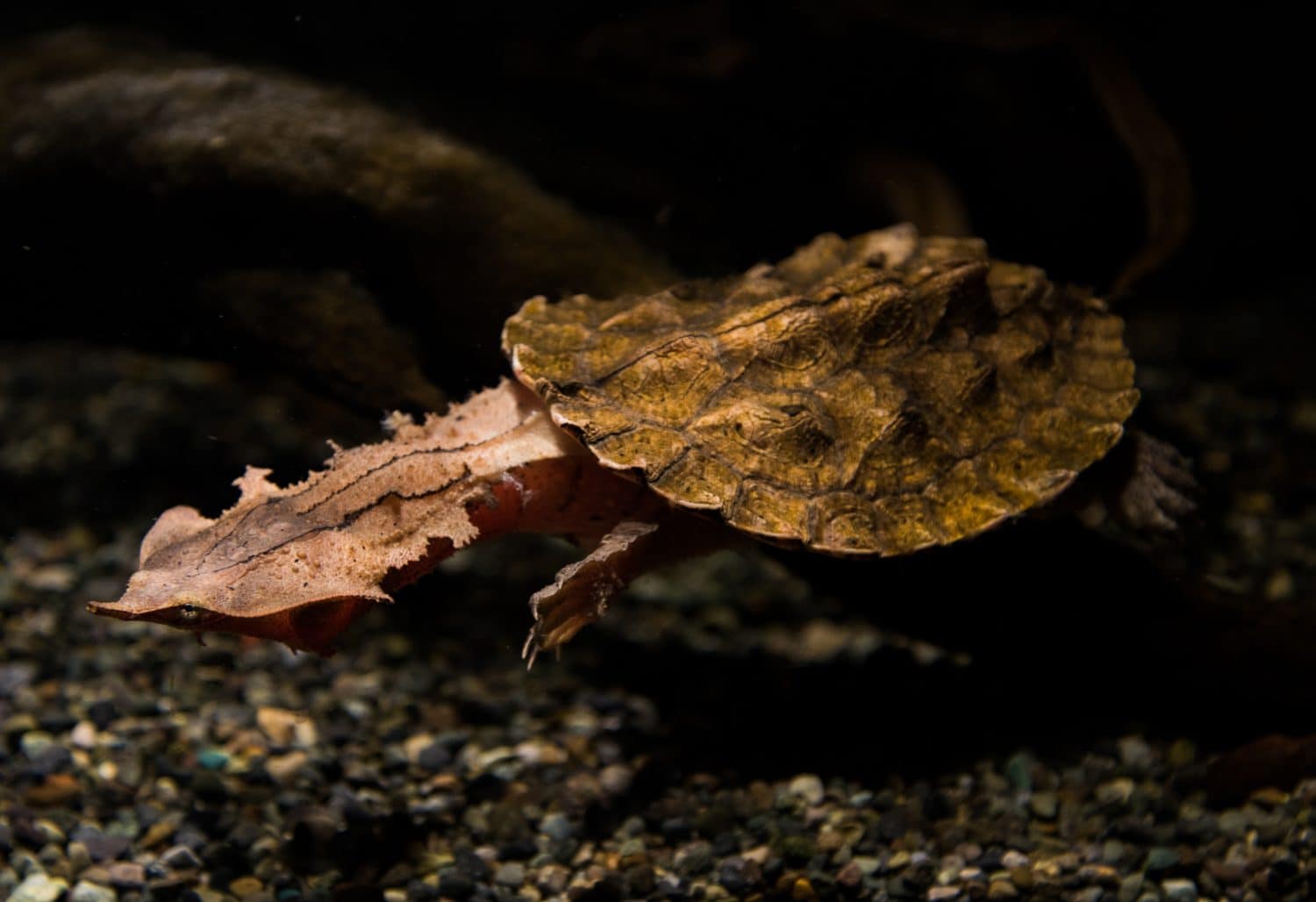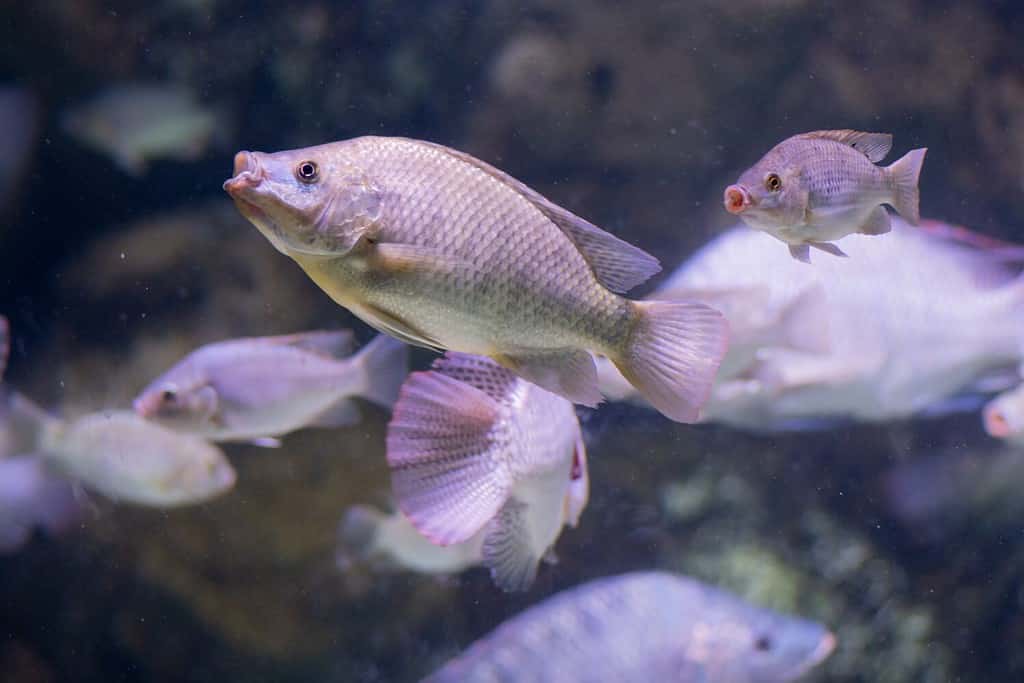The matamata is probably the ugliest turtle in the world, but its ugliness has a purpose. The coloration and shape of its carapace, limbs, and head resemble leaf and bark debris. Such debris is found on the bottoms of the stagnant rivers, creeks, marshes, and even drainage ditches where it lives. This camouflage protects the turtle from predators. In this article, we cover details of nature’s most unattractive turtles, including where to find them, what they eat, and how they reproduce.
| Matamata Info | More Matamata Info | Physical Characteristics |
|---|---|---|
| Top Speed: Very slow Age Of Sexual Maturity: 5 years Age Of Weaning: N/A Prey: Fish, aquatic worms and other invertebrates Name Of Young: Hatchlings Group behavior: Solitary Estimated population size: Unknown Biggest threat: Humans Most distinctive feature: Its ugliness Other names: Mata mata, mata-mata | Life Span: 15 to 40 years in captivity Gestation period: Eggs hatch after 200 days Litter size: 12 to 28 eggs Habitat: Turbid bodies of water Predators: None Diet: Carnivorous Type: Reptile Common name: Matamata Number of species: Two Location: Amazon river basin, Orinoco River, Trinidad, possibly Florida Group: Bale | Color: Pink to reddish brown in juveniles, brown, orange, gray, or dull yellow in adults Weight: 46 pounds Size (L): 37 inches |

The matamata is probably the world’s ugliest turtle.
©LEE EUI-ZUN/Shutterstock.com
| Scientific Classification | Matamata Location |
|---|---|
| Kingdom: Animalia | Amazon River Basin |
| Phylum: Chordata | Orinoco River |
| Class: Reptilia | Trinidad |
| Order: Testudines | Florida? |
| Family: Chelidae | |
| Genus: Chelus | |
| Species: Chelus fimbriata, C. orinocensis |
Matamata Facts
- The matamata is an aquatic turtle and is rarely seen on land.
- The tubercles and flaps of skin on its head and neck are sensitive to movement and other stimuli.
- The turtle’s snorkel-shaped snout pokes out of the water and allows the animal to stay underwater for long periods of time.
- Matamatas are largely nocturnal.
- Matamatas have spines in their throats. Biologists believe the spines, or papillae, ensure that the turtle’s prey is funneled toward its digestive system and doesn’t escape.
Matamata Scientific Name
The scientific names of the matamata are Chelus fimbriatus, or fimbriata in some reckonings, and C. orinocensis. Chelus is a Greek word for turtle. Fimbriatus is Latin for “fringed,” and orinocensis means that the turtle is from South America’s Orinoco River.
Matamata Appearance
The matamata’s appearance is unmistakable. It is a large turtle with a carapace that can be nearly 18 inches long, with three keels down its length. The plastron is small and notched at the end. The turtle spends so much time in the water that algae may nearly cover it. Without the algae, the turtle is the color of fallen leaf debris or tree bark. This is a combination of dull yellows, oranges, grays, and browns.
The matamata’s unusually long neck places it in the Chelidae family, for chelids are “snake-necked” turtles. The turtle’s head is shaped like a triangle and both the head and neck are full of skin flaps, tubercles, and barbels. All of these structures appear to have nerves that help the animal sense its environment. Its nose acts like a snorkel, and its eyes have a tapetum lucidum, much like a cat’s eyes. This helps the nocturnal turtle see in the darkness, even though its eyesight is very bad according to some scientists. The matamata has tympani that help it hear. Even though it’s an aquatic turtle, the matamata is a bad swimmer, and adults rarely move. You can tell the difference between males and females because the bottom of the male’s shell, the plastron, is concave. The female’s plastron is flat. The male’s tail is also longer and thicker than the female’s.
Matamata Behavior
Matamatas spend almost all their time in the water where they’re mostly immobile save the wavering of their skin flaps. The only time they emerge from the water is when it’s time to lay eggs, and this is a struggle because their legs are weak. They don’t bask in the sun and avoid each other outside of the breeding season.
Matamata Habitat
The matamata lives in the shallow, murky water of slow rivers, swamps, marshes, and even ditches with muddy bottoms. It’s native to the basin of the lower Amazon River and the Orinoco River. This encompasses the eastern areas of Peru, the Guianas, and Ecuador, the northern parts of Bolivia and Brazil, central Brazil, and southeastern Colombia. The turtle also lives in Trinidad, and there are reports of the matamata being seen in Florida drainage ditches.
Matamata Diet

The matamata’s diet includes small tilapias.
©SingerGM/Shutterstock.com
Matamatas mostly eat small fish such as small tilapias and other aquatic invertebrates such as mussels, insects, and worms. Now and then they take a small mammal, bird, or amphibian. These prey animals are attracted to the turtle because of its fringes and covering of algae, which look like something to eat.
The jaws of the matamata are weak. It can’t chew its prey, so has to swallow it whole. When prey comes too close, the turtle sticks out its neck and opens its mouth as wide as it can. This suction feeding causes a vacuum that pulls in both the prey and lots of water. When the turtle closes its mouth, the water is squeezed out and the prey is swallowed. Sometimes the turtle sways its neck back and forth in a search for prey, and even corrals fish into an area before it eats them.
Matamata Predators and Threats
Aside from being well camouflaged, the world’s ugliest turtle is too big, and its carapace is too thick for predators. Humans collect matamatas for the pet trade. Some people eat this turtle occasionally, but most people find it simply too ugly to deal with.
Other threats to the matamata are climate change and habitat destruction.
Matamata Reproduction and Life Cycle
The breeding season happens from October to December and is one of the few times that the turtle moves. To entice a female, a male stretches out its legs, opens and shuts its mouth, and lunges its head outward as the flaps of its head ripple. Males often mate with more than one female.
After mating the female leaves the water and creates a nest in leaf litter and decaying plant material at the edge of the forest. This is unusual, for most turtles lay their eggs in sandy river or stream banks. The female lays between 12 to 28 round, brittle eggs. The mother leaves after she lays them, and it can take 200 days for the eggs to hatch. Neither parent cares for the hatchlings.
Matamata Population
The population of the matamata is unknown as of 2023.
Matamata FAQ
Are Matamatas Carnivores, Herbivores, or Omnivores?
Matamatas are carnivores and eat small aquatic animals through suction feeding.
What Does Matamata Mean?
Matamata allegedly means “I kill” in one of the aboriginal South American languages, despite the fact that this turtle is quite biddable.
Is a Matamata a Good Pet?
Matamatas make interesting pets, though they are expensive to buy and need a certain amount of care. Their tank needs to be large, for our ugliest turtle can grow to a large size. The water should also be kept acidic, moderately to heavily filtered, and have a good number of tannins.
How Long Does the Matamata Live?
Matamatas live 15 years in captivity but there are reports of them living into their 40s and beyond.
Thank you for reading! Have some feedback for us? Contact the AZ Animals editorial team.








